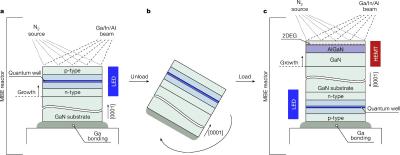Researchers from Cornell University, in collaboration with researchers from the Polish Academy of Science have developed the world's first chip that combines an LED and a transistor. This so-called Dualtronic chip could pave the way towards smaller, lower-cost and more efficient LEDs.
The researchers built their GaN device so that on one side it has a high electron mobility transistor (HEMT), and on the other side it has an LED. The researchers take advantage of a unique property of GaN - the fact that it has a large electronic polarization along its crystal axis, which gives each of its surfaces dramatically different physical and chemical properties. The gallium side is useful for photonic devices, while the Nitrogen side is useful for transistor devices.
The researchers started by growing transparent GaN substrates (400 microns thick) on a single crystal wafer, which was achieved by the PAS in Poland. Using molecular beam epitaxy (MBE) the PAS researchers then grew the HEMT and LED heterostructures. This device was shipped to Cornell, which continued to build and process the HEMT on the nitrogen polar face. The final step was to create the LED on the metal polar face, using a thick positive photo resist coating to protect the previously processed n-polar face.


